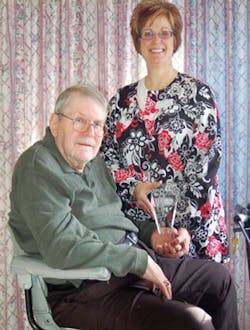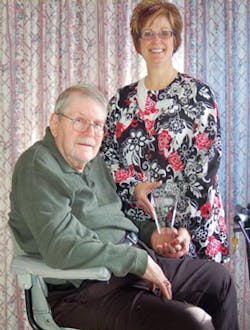Comfort care
Clinical care to comfort care ... a necessary continuum
by Angie Stone, RDH, BS
Hygienists meet new patients all the time. Our goal is to make them feel welcome, comfortable, and well taken care of. We never know which of the patients we come in contact with will change our lives, and sometimes we are surprised by the ones who do! Oftentimes, the ones who change our lives are the ones we would suspect the least. I have proof of that.
I met Ed for the first time in 1997. I was new to the office, but he certainly was not. In fact, he had been a patient since 1979, so he knew the place well and the other team members knew him well. He arrived in my operatory with the aid of a walker. Upon updating his medical history, Ed reported a history of back troubles, which included vertebrae trouble that had affected his spinal cord, which in turn affected his legs, thus the trouble walking. "Fair enough," I thought. I don't remember much else from his visit, other than he seemed to be a bit grumpy. I was not really fazed by that as grumpy patients posed a challenge to me. I typically was able to win these patients over during repeated recall appointments.
- Consider reading these articles by Angela Stone, RDH
- I Want You to Want Me
- A Pizza Just the Way You Like It
As Ed came and went from my chair every six months, what I had deemed as "grumpy" early on really turned out to be more of a smart aleck attitude or a spitfire. As time when on, I understood his personality more and more, and I was able to give him some of his own medicine so to speak, which he enjoyed.
What I also came to understand was that the disease in his vertebrae was affecting his nerves more and more. This was evident as he became more reliant on his walker. The walker was eventually replaced by a motorized scooter. The passage of time made it more and more difficult for Ed to transfer into the dental chair. What once was a 45-minute recall appointment eventually became a 60-minute appointment, simply to allow for transfer time.
When he arrived for his appointment in early 2009, he reported having made a move to a nursing home facility. This was done due to his and his wife's inability to perform the necessary ADLs (activities of daily living). I was saddened by this news, but I had also figured this would eventually happen.
My saddened state quickly changed to a horrified state when I laid eyes on Ed's oral cavity. What in the heck had happened? In my years of treating Ed clinically, I had never seen so much plaque on his teeth and had never seen generalized gingivitis. It was obvious the care he and his wife had been able to perform at home was not what was being achieved in the nursing home facility. No oral hygiene instructions I could deliver would give Ed the ability to perform his own oral hygiene adequately, even though he tried hard, as his condition had now affected his hands. I also know, based upon experience, that educating the team at the facility would not improve the oral care Ed received, so I took things into my own hands … literally.
I approached my dentist with the following request, "Please write a prescription that states I can go to the nursing home and brush and floss Ed's teeth two times a week and also prescribe two 100% xylitol-sweetened mints (1.5 g of xylitol) to be administered to Ed after each meal."
The reason I asked for a prescription was twofold. One, I was uncertain if I could go brush and floss without a dentist telling me I could, and two, I knew the mints would not get administered by nursing staff without a script, even though xylitol mints are available over the counter. The doctor mumbled something about me being crazy and then he put his pen to the prescription pad.
My visits to provide oral care procedures for Ed were enjoyable! We visited, flossed, and brushed, and managed to give each other a hard time now and again. Before long, the gingivitis had subsided and I began to stretch the times in between my visits. I learned that as long as I was there to provide my services once every 10 days, there was no bleeding of his tissues, but I usually saw Ed once a week. During the first two years of this regimen, Ed was free of any dental disease, did not require treatment from a dentist, and never needed emergency dental care.
During that time, Ed and I became good friends. We were truly good for each other! We looked forward to our visits. He listened with great enthusiasm to the trials and tribulations of my life, and I listened to those of his life gone by. He was so proud of me when I was awarded the Sunstar/RDH Award of Distinction in the fall of 2012. After all, what he and I had accomplished was one of the reasons I received the award!
He was instrumental in enrolling some of his fellow residents in a case study I completed, where I opened up Ed's and my protocol to 45 other residents. He was my cheerleader, a sounding board, and an advisor. He was elated when I was asked to present the results of our case study at the International Xylitol Symposium, held in Cancun, Mexico, in February 2013. As a result of the presentation, the case study will be published in a peer-reviewed journal in the summer/fall of 2013, and we are planning on a more extensive scientific study of this model of care.
I told Ed I would show him the study results when I returned from the symposium. We were both excited! I arrived at the nursing home with computer in hand and a smile on my face. It was going to be wonderful to share this with Ed. But I found an empty room. No sign of Ed or any of his belongings. Almost panic stricken, I searched for a staff member. "Where is Ed?" I asked. "We have moved him to a different room." I was relieved to hear he was still in the building. The next thing I was told was, "Ed has had a change in his condition. He went to the hospital and recently returned. He is in comfort care only now." Not really processing what they had said to me, I asked, "So … what does that mean?" They replied, "He will die over the next few days. You won't be able to brush and floss his teeth. He isn't very coherent." I asked if I could see him, and they said of course.
My visit was brief. Never … in three years … had I seen him in his bed or in a hospital gown. He was not able to speak to me, and I had no idea if he understood anything I said to him. I had no idea how to handle the situation, so I left, in tears.
After breaking down and finally able to get my composure back and my thoughts together, I returned to see Ed the following day. His mouth was dry, as he was not being given anything by mouth. He was unable to swallow anything substantial. His tongue was coated and crusty; his teeth were becoming covered with plaque. I picked up the dreaded toothette that was sitting in a plastic cup filled with water. I began to brush his teeth with it. He intuitively sucked the water out of the sponge. The crust on his tongue softened and I was able to remove it with the toothette. Things seemed much better when I was done.
My "comfort care" continued for several days. He welcomed the water on the toothette and was able to signal to me when he had had enough. Some days, Ed was able to nod or shake his head appropriately to the questions I asked him. Sometimes he could even whisper a yes or no. I read the paper to him one day, which was an everyday event for him prior to his "condition change." I told him what had been going on in my life. One huge part of our visits was missing, though … actually speaking with Ed. I told him I wished he could talk to me. He mouthed, "I wish I could too." But it wasn't in the master plan. Neither was Ed seeing our case study results, I guess.
On March 5, 2013, I said good-bye to Ed and assured him I would be back on March 10 for his birthday, as my work travels were taking me away for a few days. As I was in the plane, I wrote this article. I received word Ed passed away on March 7.
Some people think being a hygienist is mostly about cleaning teeth. Ed and I beg to differ. Being a hygienist is about human beings, teaching, learning, and relationships. Ed was placed in my path for a reason and I in his. While I will not speak to Ed with voices again, he will continue to guide me wherever this road is supposed to go. I believe Ed now knows the master plan. His memory will live on in me and will be carried forward through other people I will be able to assist because of what Ed taught me both professionally and personally. Rest peacefully, Ed, until we meet again. RDH
Angie Stone, RDH, BS, has been speaking through her company HyLife, LLC, educating at trade shows, teaching in dental assisting/dental hygiene programs, and consulting in offices. She has educated dental professionals in 35 states and four countries to date. Her articles have been published in a variety of dental hygiene publications. She continues to promote the Adopt a Nursing Home Initiative and the Stonkowski Project … They Shouldn't Die of Dirty Teeth. Angie was recognized for her work with the elder population with being awarded the RDH Sunstar Award of Distinction in 2012.
Past RDH Issues

